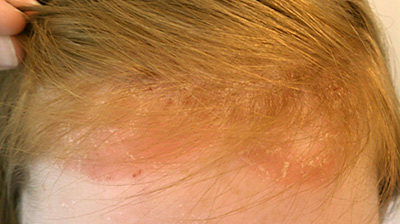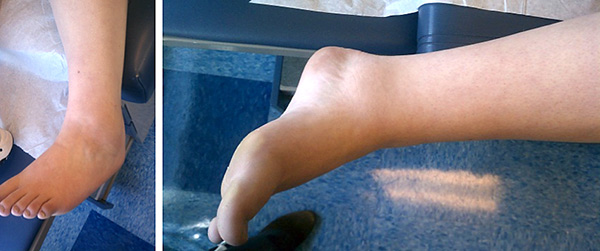An eight-year-old child is brought into your general pediatric practice by her mother for a rash. The family has noticed these changes to her forehead.

On further examination you find the following, in the image at right, that had not been noticed by the family.
- What do you tell the family?
- This is ringworm
- This is psoriasis
- This is eczema
- This is morphia (localized scleroderma)
- What related issues need particularly to be screened for on review of systems?
- Immunodeficiency
- Allergies and asthma
- Renal disease
- Joint pain

- The child has not complained of any joint pain even though she has been participating in a competitive soccer league. What do you tell the family about the joint swelling?
- The joint swelling is unrelated to the rash and does not require treatment
- The joint swelling is unrelated to the rash but requires treatment
- The joint swelling is related to the rash but does not require treatment
- The joint swelling is related to the rash and requires treatment
- The child needs ongoing ophthalmologic exams to screen for associated eye disease.
- True
- False
-
Question 1
Correct answer: B - This is psoriasis
It is common for psoriasis to involve the scalp. The lesions pictured have the typical scaly quality of psoriatic plaques. The bleeding of psoriatic plaques when they are disturbed is referred to as Auspitz’s sign.
Ringworm can occur to the scalp (tinea capitus) though is generally more circumscribed. It would be unusual for eczema to involve the scalp. Morphia can involve the scalp, but would have a bound-down look to the skin rather than scale, and may be associated with atrophy of underlying structures.
Question 2
Correct answer: D - joint pain
Psoriasis can be associated with inflammatory arthritis, referred to as psoriatic arthritis. This is a diagnosis that is distinct from rheumatoid arthritis. The arthritis of psoriatic arthritis can precede the development of skin lesions in some patients. Psoriasis is seen in immunocompetent patients, so does not raise concerns for an immunodeficiency. Psoriasis is not particularly associated with atopic diseases such as allergies and asthma, though eczema may have such an association. Psoriasis does not have an association with renal disease.
Question 3
Correct answer: D - the joint swelling is related to the rash and requires treatment
The joint swelling is that of psoriatic arthritis, so is related to the rash. Psoriatic arthritis can cause permanent joint damage, and therefore requires treatment to control the disease, even if the child has not complained of pain.
Question 4
Correct answer: True
Children with psoriatic arthritis are at risk for uveitis, as are children with other forms of juvenile idiopathic arthritis.